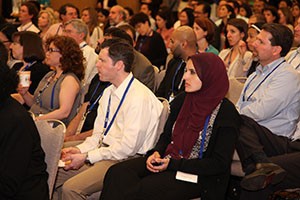
Photo: Steve Schneider
ATS members seeking a way to contribute to their fields, learn from the best, or even fast track their careers should look no further than the Society’s assemblies, sections, and working groups.
“During the ATS 2015 International Conference in Denver, assembly members have the chance to greet one another at meetings, receptions, dinners, and even in the hallways between sessions,” says ATS President Thomas Ferkol, MD. “It is the perfect time to meet with leaders and express your interest of becoming more involved in the assembly and the Society.”
The 14 assemblies of the ATS cover the depth and breadth of respiratory, critical care, and sleep medicine. The purpose of an assembly is to improve the collection, interpretation, and dissemination of information; improve communication among members; and participate in the planning of the International Conference. Assemblies are also responsible for creating and updating ATS documents, including statements, guidelines, and workshop reports.
Assemblies also offer a forum for members to launch projects and activities that benefit their own work in the field and the ATS at large. For new ATS members, assemblies represent a conduit for ensuring that the greatest benefits of ATS membership are attained.
Lynn Gerald, PhD, MSPH, Canyon Ranch Endowed Chair, department of health promotion sciences, College of Public Health, University of Arizona, Tucson, calls the ATS Assembly on Behavioral Sciences and Health Sciences Research her “professional home.” Dr. Gerald attended her first ATS international conference in 1998. “I was surprised that there was actually a medical organization that had a place for behavioral scientists,” she says. “I think that’s probably what’s kept me in pulmonary disease, and I’ve really enjoyed it.”
Lynn Reinke, PhD, ARNP, clinical assistant professor, biobehavioral nursing, University of Washington School of Nursing, Edmonds, has served as chair of the Nursing Assembly. “Over the years I have been on many committees and being in those leadership positions, I learned from other incredible role models as leaders, but it also really helped to develop my own professional skills,” she says. “So it’s really a win-win opportunity and there are many, many opportunities to become involved in committee work and in leadership in the ATS.”
Working Groups and Sections
Assemblies can choose to form working groups under the purview and approval of the current assembly chair. Working groups consist of five to 12 assembly members. The goals of working groups are to facilitate effective collaboration between assembly executive committees and assembly members, develop assembly/committee project proposals, identify learning gaps in specific disease categories, and assess assembly membership needs.
Sections are subdivisions of an assembly that focus on a specific area of interest within the scope of an assembly. The three ATS sections are the Section on Genetics and Genomics (housed under the Assembly on Allergy, Immunology and Inflammation), the Section on Terrorism and Inhalation Disasters (housed under Assembly on Environmental Occupational and Population Health) and the Section on Medical Education (housed under the Behavioral Science and Health Services Research Assembly).
You can become active in an assembly by attending the annual Assembly Membership Meeting. Twelve assemblies will hold their membership meetings from 5 to 7 p.m. on Monday, May 18. The Assembly on Pediatrics and the Assembly on Behavioral Science and Health Services Research will conduct their membership meetings from 6:30 to 8:30 p.m. on Sunday, May 17.

